Map of
Greece showing Neolithic sites (clickable map). | |
| Period | Neolithic Europe |
|---|---|
| Dates | c. 7000 – c. 3200 BC |
| Major sites | Nea Nikomedeia, Sesklo, Dimini, Franchthi Cave, Athens, Knossos, Milos |
| Characteristics | Socioeconomic and architectural developments |
| Preceded by | Balkan Mesolithic, Pre-Pottery Neolithic B |
| Followed by | Sesklo culture, Cycladic culture, Minoan civilization, Helladic period, Cardium pottery, Starčevo culture, Eutresis culture, Korakou culture, Tiryns culture |
| History of Greece |
|---|
 |
|
|
Neolithic Greece is an archaeological term used to refer to the Neolithic phase of Greek history beginning with the spread of farming to Greece in 7000–6500 BC, and ending around 3200 BC. During this period, many developments occurred such as the establishment and expansion of a mixed farming and stock-rearing economy, architectural innovations (i.e. " megaron-type" and "Tsangli-type" houses), as well as elaborate art and tool manufacturing. Neolithic Greece is part of the Prehistory of Southeastern Europe.
Periodization
The Neolithic Revolution reached Europe beginning in 7000–6500 BC, during the Pre-Pottery Neolithic B period, when agriculturalists from the Near East entered the Greek peninsula from Anatolia mainly by island-hopping through the Aegean Sea. [1] Modern archaeologists have divided the Neolithic period of Greek history into six phases: Pre-Pottery, Early Neolithic, Middle Neolithic, Late Neolithic I, Late Neolithic II and Final Neolithic (or Chalcolithic).
| Period | Approximate date |
|---|---|
| Pre-Pottery (or Aceramic) | 6800–6500 BC [2] |
| Early Neolithic | 6500–5800 BC [3] |
| Middle Neolithic | 5800–5300 BC [4] |
| Late Neolithic I | 5300–4800 BC [5] |
| Late Neolithic II | 4800–4500 BC [6] |
| Final Neolithic (or Chalcolithic) | 4500–3200 BC [7] |
Sites of Neolithic Greece
These are the estimated populations of hamlets, villages, and towns of Neolithic Greece over time. There are several problems with estimating the sizes of individual settlements, and the highest estimates for a given settlements, in a given period, may be several times the lowest.
| Town | 7000 BC | 6000 BC | 5000 BC | 4000 BC | 3800 BC | 3700 BC |
|---|---|---|---|---|---|---|
| Nea Nikomedeia | 500–700 [8] | |||||
| Sesklo | 1000–5000 [9] | |||||
| Dimini | ||||||
| Athens | ||||||
| Poliochne | ||||||
| Knossos | 25 | 50 | 500–1000 | 500–1000 [11] | ||
| Trapeza | ||||||
| Gerani | ||||||
| Lerna | ||||||
| Kefala | ||||||
| Alepotrypa cave | ||||||
| Milos | ||||||
| Servia |
Pre-Ceramic 6800–6500 BC
The Pre-Ceramic (or Aceramic) period of Neolithic Greece is characterized by the absence of baked clay pots and an economy based on farming and stock-rearing. [2] Settlements consisted of subterranean huts partially dug into the ground with communities inhabited by 50 to 100 people in places such as Argissa ( Thessaly), Dendra ( Argolid) and Franchthi. [2] The inhabitants cultivated various crops (i.e. einkorn, emmer wheat, barley, lentils and peas), engaged in fishing, hunting, animal husbandry (i.e. raising cattle, pigs, sheep, dogs and goats), developed tools (i.e. blades made from flint and obsidian) and produced jewellery from clay, seashells, bone and stone. [2]
Knossos has an extremely long history that begins during the Pre-Ceramic period. The first Neolithic settlements in Knosos area were developed in 6,500 - 7,000 BC according to modern radiocarbon. Arthur Evans, who revealed the Minoan Knossos palace, estimated that during the late 8th Millennium or early 9th Millennium BC Neolithic people arrived in the area, probably from overseas, possibly from Western Anatolia and established their primitive communities in the local hill. [12]
The volcanic island of Milos has been visited for the exploitation of its obsidian for the manufacture of tools and weapons, from the Mesolithic until the late Neolithic period. Natural resources from Milos were transported over vast distances all over the Aegean, mainland Greece, Western Anatolia and possibly as far as Egypt. [13] The oldest findings of Milos obsidians outside the island occurs in the Mesolithic (9000–7800 BC), at the Franchti cave in the Argolid. There is no evidence of settlements on Milos island until the Final Neolithic (4000 BC). The exploitation of obsidian seems to be performed by groups of different people landing intermittently on the island, for the periodic supply of stone for tools making. [14]
Early Neolithic (EN) 6500–5800 BC
The Pre-Ceramic period of Neolithic Greece was succeeded by the Early Neolithic period (or EN) where the economy was still based on farming and stock-rearing and settlements still consisted of independent one-room huts with each community inhabited by 50 to 100 people (the basic social unit was the clan or extended family). [3] Hearths and ovens were constructed in open spaces between the huts and were commonly used. [3] During the Early Neolithic period, pottery technology involving the successful firing of vases was developed and burial customs consisted of inhumation in rudimentary pits, cremation of the dead, bone collection, and cemetery interment. [3]
-
Ancient Greece Early and Middle Neolithic Clay Figurines from Thessaly, 6500-5300 BC.
-
Ancient Greek Early and Middle Neolithic pottery 6500-5300 BC. National Museum of Archaeology, Athens.
-
Monochrome bowls from Sesklo. Early Neolithic period (6500-5800 BC). Archaeological Museum Athens
-
Neolithic clay cups from Sesklo. National Museum Athens
-
Obsidian, used for making tools and weapons
Middle Neolithic (MN) 5800–5300 BC
The Middle Neolithic period (or MN) is characterized by new architectural developments such as houses constructed with stone foundations and the development of megaron-type dwellings (rectangular one-roomed houses with open or closed porches). [4] Furthermore, the "Tsangli-type" house, named after the settlement of Tsangli, was first developed during the Middle Neolithic period; the "Tsangli-type" dwelling has two interior buttresses on each side (designed to support the roof of the house and divide the dwelling space into separate rooms for distinct functions such as storage, food preparation and sleep quarters) with a row of posts in the center of the square room. [4] In the realm of art, the meander-labyrinth motif was found on seals and jewellery of the Early Neolithic period and, to a lesser extent, of the Middle Neolithic period. [4] The Middle Neolithic period ended with the devastation of certain settlements by fire; communities such as Sesklo were abandoned whereas communities such as Tsangli-Larisa were immediately re-inhabited. [4]
-
Female figurine, marble, Thessaly, 5300–3300 BC
-
Female figurine of a woman holding a baby, Sesklo, Neolithic, 4800–4500 BC
-
Findings from Sesklo, Neolithic Period, c. 5300 BC
-
Ancient Greece Neolithic stone figurine, 6500-3300 BC.
-
Ancient Greece Neolithic clay figurines, 6500-3300 BC.
-
Ancient Greece Neolithic stone tools and weapons.
-
Ancient Greece Neolithic stone grinder.
Late Neolithic (LN) 5300-4500 BC
Late Neolithic I (LNI)
The Late Neolithic I period (or LNI) is characterized by settlement expansion and the intensification of the farming economy where shrubs and wooded areas were cleared in order to secure grazing fields and arable lands. [5] During this period, new crops were cultivated such as bread wheat, rye, millet and oat (food was prepared in hearths and ovens usually found inside houses). [5] Animals such as sheep and goats were raised for their wool, which was used to weave garments. [5] Communities were inhabited by 100–300 individuals socially organized into nuclear families and settlements consisted of large megaron-type rectangular structures with timber-post frames and stone foundations. [5] Many settlements were surrounded by ditches 1.5–3.5 meters deep and 4–6 meters wide, which were constructed probably to defend against wild animals and to protect goods by establishing the borders of the settlements themselves. [5]
Late Neolithic II (LNII)
The Late Neolithic I period was succeeded by the Late Neolithic II period (or LNII) where economic and social life in existing settlements continued uninterruptedly. [6]
-
Clay vase with polychrome decoration, Dimini, Magnesia, Late or Final Neolithic (5300-3300 BC). Ceramic; height: 25 cm (93⁄4 in.), diameter at rim: 12 cm (43⁄4 in.); National Archaeological Museum ( Athens).
Final Neolithic (FN) 4500–3200 BC
The Final Neolithic (or Chalcolithic) period entails the transition from the Neolithic farming and stock-rearing economy to the metal-based economy of the Early Bronze Age. [7] This transition occurred gradually when Greece's agricultural population began to import bronze and copper and used basic bronze-working techniques first developed in Asia Minor with which they had cultural contacts. [15]
The Alimia and Rhodes islands had Neolithic settlements. Specifically in Alimia the settlement was on a mountain in the center of the island, which provided perfect view of the entire local area and protection. Ruins of Neolithic stone buildings were revealed during archeological research. [16]
Eutresis culture developed during the ending period of the Final Neolithic. It was based on the Final Neolithic culture of central and southern Greece. It lasted until the Early Helladic II. [17]
Society
The social classes of the late Neolithic communities were strictly distinguished into free men and slaves; a phenomenon that continued until the early Mycenaean period. [18]
-
Figurine of the Karditsa Thinker, Thessaly, 4500-3300 BC
-
Gold ornaments [19]
-
Gold ornaments [20]
Warfare in Neolithic Greece
Destruction of Sesklo
The remains of Sesklo indicate fire and destruction, a sign of armed conflict. Dimini is often blamed for the destruction of Sesklo but other causes might be responsible for the fire in the Neolithic settlement.
Skeletal remains
The skeletal remains from Alepotrypa cave in southern Greece exhibit levels of trauma that might be related to warfare. The examination of 69 Late and Final Neolithic skeletons revealed that more than 10% of the individuals exhibited healed depressed skull fractures. Anastasia Papathanasiou, Clark Spencer Larsen and Lynette Norr noted that "All fractures are small, circular, and well healed at the time of death, and are found in adult males and females and sub-adults.", [21] namely the appearance of the wounds suggests that the blows were similar regardless of the victim's age or sex. Some individuals show multiple fractures, mostly nonlethal. [22]
Fortifications
Both Dimini and Sesklo had walls and strongpoints. Similar basic fortifications were common in Neolithic settlements across Greece; a sign of existing dangers and primitive military knowledge. [23] Simple fortifications, which account for the majority of Neolithic sites, included small walls and ditches, or a combination of the two encircling the area (at least partially). The settlement of Nea Nikomedeia had two concentric ditches. Neolithic Makriyalos had two lines of ditches with V-shaped sections; the inner ditch was ~4 meters deep and was strengthened by small stone walls. The most effective fortifications were discovered in Dimini and Sesklo. Sesklo's acropolis was enclosed by 1.5 meter thick wall and gates that were easily defended. Dimini's acropolis had walls with narrow gateways, that were encircling a small compound. [22]
Genetic studies
A 2016 archaeogenetic study, titled "Early farmers from across Europe directly descended from Neolithic Aegeans", studied two Mesolithic samples collected from the site of Theopetra in Greece, and five Neolithic samples from both sides of the Aegean; three of them from the northern Greek mainland (sites of Revenia, Paliambela and Kleitos) and two from northwestern Anatolia (site of Barcın). The study showed that farming was spread in Europe via demic diffusion and not through trans-cultural diffusion to indigenous hunter-gatherers. Also, the early farmers of the Aegean shared a direct genetic link with the Neolithic farmers from across Europe, and all of them ultimately originated from farming communities of western Anatolia. Expansion of these Anatolian farming communities into the Aegean and mainland Greece had likely begun by at least the mid-8th millennium BCE, as the two Mesolithic Greek samples dated between 7,605-6,771 BCE, possessed an mtDNA haplogroup that is observed in Neolithic farmers from across Europe, namely K1c. Furthermore, the mtDNA haplogroups of all five Neolithic samples that were studied also belonged to typical haplogroups of central European Neolithic farmers and modern Europeans, but not of Mesolithic European hunter-gatherers; namely X2b (Revenia), X2m (Barcın), K1a2 (Barcın), J1c1 (Paliambela), and K1a2 (Kleitos). Likewise, the Y-DNA haplogroup of the two Neolithic males was G2a2, a typical lineage among European Neolithic farmers, but not among Mesolithic hunter-gatherers. PCA analysis showed that all five Neolithic Aegean samples tightly clustered with early Neolithic samples from central and southern Europe, which substantiates a migration of early European farmers from the northern Aegean into and across Europe. [24]
| Site | Period | Sample Code | Date | Sex | mtDNA | Y-DNA |
|---|---|---|---|---|---|---|
| Theopetra | Mesolithic | Theo5 | 7,605–7,529 BCE | – | K1c | – |
| Theopetra | Mesolithic | Theo1 | 7,288–6,771 BCE | – | K1c | – |
| Revenia | Early Neolithic | Rev5 | 6,438–6,264 BCE | XX | X2b | * |
| Barcın | Early Neolithic | Bar31 | 6,419–6,238 BCE | XY | X2m | G2a2b |
| Barcın | Early Neolithic | Bar8 | 6,212–6,030 BCE | XX | K1a2 | * |
| Paliambela | Late Neolithic | Pal7 | 4,452–4,350 BCE | XX | J1c1 | * |
| Kleitos | Final Neolithic | Klei10 | 4,230–3,995 BCE | XY | K1a2 | G2a2a1b |
- ^ –, indicates no genomic data available; *, indicates not applicable.
A 2017 archaeogenetic study, titled "Genetic origins of the Minoans and Mycenaeans", analyzed 10 Minoan and 4 Mycenaean samples, and found that both population groups shared at least 75% of their autosomal ancestry with the Neolithic farmers of western Anatolia and the Aegean, commonly known as Early European Farmers. The study also showed that modern Greeks resemble the Mycenaeans, but with some dilution of the early Neolithic ancestry due to later admixture. [25]
Gallery
-
Map of the world showing approximate centers of origin of agriculture and its spread in prehistory. [26]
-
A map showing the Neolithic expansions from the 7th to the 5th millennium BCE, including the Cardium culture in blue.
-
Neolithic pottery styles of Ancient Greece
-
Neolithic expansion in Europe
-
Neolithic settlement of Sesklo in central Greece, one of the most advanced settlements of its era
-
Neolithic settlements of Nea Nikomedeia, close to Krya Vrysi
See also
References
Citations
- ^ Pashou, Drineas & Yannaki 2014, p. 5: "The earliest Neolithic sites with developed agricultural economies in Europe dated 8500–9000 BPE are found in Greece. The general features of material culture of the Greek Neolithic and the genetic features of the preserved crops and associated weeds of the earliest Greek Neolithic sites point to Near Eastern origins. How these Near Eastern migrants reached Greece is a matter of speculation. [...] Our data support the Anatolian rather than the Levantine route because they consistently show the Aegean islands to be connected to the Near East through Anatolia. Archaeological evidence from Greek and Near Eastern and Anatolian Neolithic sites suggests that multiple waves of Neolithic migrants reached Greece and Southern Europe. Most likely multiple routes were used in these migrations but, as our data show, the maritime route and island hopping was prominent."
- ^ a b c d "Neolithic Period in Greece: Pre-Ceramic Neolithic". Athens: Foundation of the Hellenic World. 1999–2000.
- ^ a b c d "Neolithic Period in Greece: Early Neolithic". Athens: Foundation of the Hellenic World. 1999–2000.
- ^ a b c d e "Neolithic Period in Greece: Middle Neolithic". Athens: Foundation of the Hellenic World. 1999–2000.
- ^ a b c d e f "Neolithic Period in Greece: Late Neolithic I". Athens: Foundation of the Hellenic World. 1999–2000.
- ^ a b "Neolithic Period in Greece: Late Neolithic II". Athens: Foundation of the Hellenic World. 1999–2000.
- ^ a b "Neolithic Period in Greece: Final Neolithic or Chalcolithic". Athens: Foundation of the Hellenic World. 1999–2000.
- ^ Milisauskas 2011, p. 182.
- ^ Runnels & Murray 2001, p. 146: "Theocharis believed that the entire area from there to the upper acropolis of the site was filled with habitations and that Sesklo was a town of perhaps 5,000 people, rather than a village. Other archaeologists working at the site have reduced the population estimate to between 1,000 and 2,000, but either way, Sesklo was a settlement of impressive size in its day."
- ^ "Ministry of Culture and Sports | Archaeological site of Poliochni at Kaminia area". odysseus.culture.gr. Retrieved 2019-01-12.
- ^ Evans, Arthur (1921). The Palace of Minos: A Comparative Account of the Successive Stages of the Early Cretan Civilization as Illustrated by the Discoveries at Knossos. Cambridge University Press. ISBN 978-1-108-06101-8.
- ^ Bleda S., During (2011). The prehistory of Asia Minor. Cambridge University Press. p. 126.
- ^ Abulafia, David (2011). The Great Sea: A Human History of the Mediterranean. United Kingdom: Allen Lane. pp. 136–137, 161.
- ^ Arias, A.; Oddone, M.; Bigazzi, G.; Di Muro, A.; Principe, C.; Norelli, P. (May 2006). "Newdata for the characterization of Milos obsidians". Journal of Radioanalytical and Nuclear Chemistry. 268 (2): 371. doi: 10.1007/s10967-006-0183-9. ISSN 1588-2780. S2CID 97361081.
- ^ Pullen 2008, p. 20; van Andel & Runnels 1988, "The transition to the Early Bronze Age", pp. 238–240; French 1973, p. 53.
- ^ Sampsom, Adamadios (2003). Η Νεολιθική Περίοδος Στα Δωδεκάνησα. Athens: Έκδοση του Ταμείου Αρχαιολογικών Πορων και Απαλλοτρίωσεων .
- ^ Rutter, Dr. Jeremy (4 January 2017). "The Eutresis and Korakou cultures of early Helladic I-II". Retrieved 2023-12-10.
- ^ Gschnitzer, Fritz; Chaniotis, Angelos (May 2012). Ιστορία της Αρχαίας Ελληνικής Κοινωνίας (in Greek). National Bank of Greece Cultural Foundation. pp. 67–68. ISBN 9789602504802.
- ^ "The 'Neolithic Treasure'". National Museum of Archaeology, Athens.
- ^ "The 'Neolithic Treasure'". National Museum of Archaeology, Athens.
- ^ Papathanasiou, Anastasia; Larsen, Clark Spencer; Norr, Lynette (30 June 2000). "Bioarchaeological inferences from a Neolithic ossuary from Alepotrypa Cave, Diros, Greece". International Journal of Osteoarchaeology. 10 (3): 218. doi: 10.1002/1099-1212(200005/06)10:3<210::AID-OA523>3.0.CO;2-2. ISSN 1099-1212.
- ^
a
b Curtis N. Runnels, Claire Payne, Noam V. Rifkind, Chantel White, Nicholas P. Wolff and Steven A. LeBlanc (2009).
"Warfare in Neolithic Thesally".
The American School of Classical Studies at Athens .
JSTOR
25622691.
{{ cite book}}: CS1 maint: multiple names: authors list ( link) - ^ Health, Julian (2017). "Warfare in Neolithic Europe". United Kingdom: Pen and Sword Books.
- ^ a b Hofmanová, Zuzana; Kreutzer, Susanne; Hellenthal, Garrett; Sell, Christian; Diekmann, Yoan; Díez-del-Molino, David; van Dorp, Lucy; López, Saioa; Kousathanas, Athanasios; Link, Vivian; Kirsanow, Karola; Cassidy, Lara M.; Martiniano, Rui; Strobel, Melanie; Scheu, Amelie; Kotsakis, Kostas; Halstead, Paul; Triantaphyllou, Sevi; Kyparissi-Apostolika, Nina; Urem-Kotsou, Dushka; Ziota, Christina; Adaktylou, Fotini; Gopalan, Shyamalika; Bobo, Dean M.; Winkelbach, Laura; Blöcher, Jens; Unterländer, Martina; Leuenberger, Christoph; Çilingiroğlu, Çiler; Horejs, Barbara; Gerritsen, Fokke; Shennan, Stephen J.; Bradley, Daniel G.; Currat, Mathias; Veeramah, Krishna R.; Wegmann, Daniel; Thomas, Mark G.; Papageorgopoulou, Christina; Burgera, Joachim (6 June 2016). "Early farmers from across Europe directly descended from Neolithic Aegeans". PNAS. 113 (25): 6886–6891. Bibcode: 2016PNAS..113.6886H. doi: 10.1073/pnas.1523951113. ISSN 0027-8424. PMC 4922144. PMID 27274049.
- ^ Lazaridis, Iosif; Mittnik, Alissa; Patterson, Nick; Mallick, Swapan; Rohland, Nadin; Pfrengle, Saskia; Furtwängler, Anja; Peltzer, Alexander; Posth, Cosimo; Vasilakis, Andonis; McGeorge, P.J.P.; Konsolaki-Yannopoulou, Eleni; Korres, George; Martlew, Holley; Michalodimitrakis, Manolis; Özsait, Mehmet; Özsait, Nesrin; Papathanasiou, Anastasia; Richards, Michael; Roodenberg, Songül Alpaslan; Tzedakis, Yannis; Arnott, Robert; Fernandes, Daniel M.; Hughey, Jeffery R.; Lotakis, Dimitra M.; Navas, Patrick A.; Maniatis, Yannis; Stamatoyannopoulos, John A.; Stewardson, Kristin; Stockhammer, Philipp; Pinhasi, Ron; Reich, David; Krause, Johannes; Stamatoyannopoulos, George (10 August 2017). "Genetic origins of the Minoans and Mycenaeans". Nature. 548 (7666): 214–218. Bibcode: 2017Natur.548..214L. doi: 10.1038/nature23310. ISSN 0028-0836. PMC 5565772. PMID 28783727.
- ^ Diamond & Bellwood 2003, pp. 597–603. The world map depicts agricultural centers in the Fertile Crescent (11,000 BP), the Yangtze and Yellow River basins (9,000 BP) and the New Guinea Highlands (9,000–6,000 BP), Central Mexico (5,000–4,000 BP), Northern South America (5,000–4,000 BP), sub-Saharan Africa (5,000–4,000 BP, exact location unknown), and eastern North America (4,000–3,000 BP).
Sources
- Atkinson, Quentin D.; Gray, Russel D. (2006). "Chapter 8: How Old is the Indo-European Language Family? Illumination or More Moths to the Flame?". In Forster, Peter; Renfrew, Colin (eds.). Phylogenetic Methods and the Prehistory of Languages. Cambridge: McDonald Institute for Archaeological Research. pp. 91–109. ISBN 978-1-902937-33-5.
- Diamond, Jared; Bellwood, Peter (2003). "Farmers and Their Languages: The First Expansions". Science. 300 (5619): 597–603. Bibcode: 2003Sci...300..597D. CiteSeerX 10.1.1.1013.4523. doi: 10.1126/science.1078208. PMID 12714734. S2CID 13350469.
- French, D.M. (1973). "Migrations and 'Minyan' pottery in western Anatolia and the Aegean". In Crossland, R.A.; Birchall, Ann (eds.). Bronze Age Migrations in the Aegean. Park Ridge, NJ: Noyes Press.
- Gray, Russel D.; Atkinson, Quentin D. (2003). "Language-tree Divergence Times Support the Anatolian Theory of Indo-European Origin". Nature. 426 (6965): 435–439. Bibcode: 2003Natur.426..435G. doi: 10.1038/nature02029. PMID 14647380. S2CID 42340.
- Milisauskas, Sarunas (2011). "Chapter 7: Early Neolithic, the First Farmers in Europe, 7000–5500/5000 BC". In Milisauskas, Sarunas (ed.). European Prehistory: A Survey (2nd ed.). New York: Springer Science and Business Media, LLC. pp. 153–222. ISBN 978-1-44-196633-9.
- Runnels, Curtis Neil; Murray, Priscilla (2001). Greece Before History: An Archaeological Companion and Guide. Stanford, CA: Stanford University Press. ISBN 978-0-80-474050-0.
- Owens, Gareth Alun (2007). "Η Δομή της Μινωικής Γλώσσας ["The Structure of the Minoan Language"]" (PDF) (in Greek). Heraklion: TEI of Crete –Daidalika. Archived from the original (PDF) on 2016-06-03. Retrieved 2014-12-14.
- Pashou, Peristera; Drineas, Petros; Yannaki, Evangelia (2014). "Maritime Route of Colonization of Europe". Proceedings of the National Academy of Sciences of the United States of America. 111 (25): 9211–9216. Bibcode: 2014PNAS..111.9211P. doi: 10.1073/pnas.1320811111. PMC 4078858. PMID 24927591.
- Pullen, Daniel (2008). "The Early Bronze Age in Greece". In Shelmerdine, Cynthia W. (ed.). The Cambridge Companion to the Aegean Bronze Age. Cambridge and New York: Cambridge University Press. pp. 19–46. ISBN 978-0-521-81444-7.
- van Andel, Tjeerd H.; Runnels, Curtis N. (June 1988). "An essay on the 'emergence of civilization' in the Aegean world". Antiquity. 62 (235): 234–247. doi: 10.1017/S0003598X00073968. ISSN 0003-598X. S2CID 163438965. Retrieved 31 December 2021.
External links
![]() Media related to
Neolithic in Greece at Wikimedia Commons
Media related to
Neolithic in Greece at Wikimedia Commons






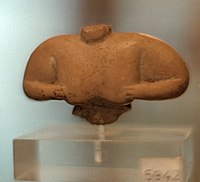

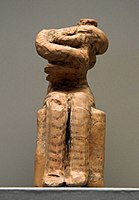



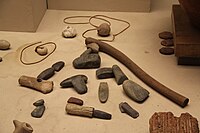
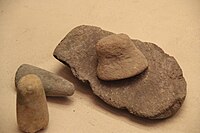


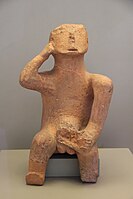
![Gold ornaments[19]](https://upload.wikimedia.org/wikipedia/commons/thumb/e/e0/Ancient_Greece_Neolithic_Gold_Ornaments_%2828421389976%29.jpg/133px-Ancient_Greece_Neolithic_Gold_Ornaments_%2828421389976%29.jpg)
![Gold ornaments[20]](https://upload.wikimedia.org/wikipedia/commons/thumb/5/5b/Ancient_Greece_Neolithic_Gold_Ornaments_%2827837612183%29.jpg/133px-Ancient_Greece_Neolithic_Gold_Ornaments_%2827837612183%29.jpg)
![Map of the world showing approximate centers of origin of agriculture and its spread in prehistory.[26]](https://upload.wikimedia.org/wikipedia/commons/thumb/e/e9/Centres_of_origin_and_spread_of_agriculture.svg/120px-Centres_of_origin_and_spread_of_agriculture.svg.png)





